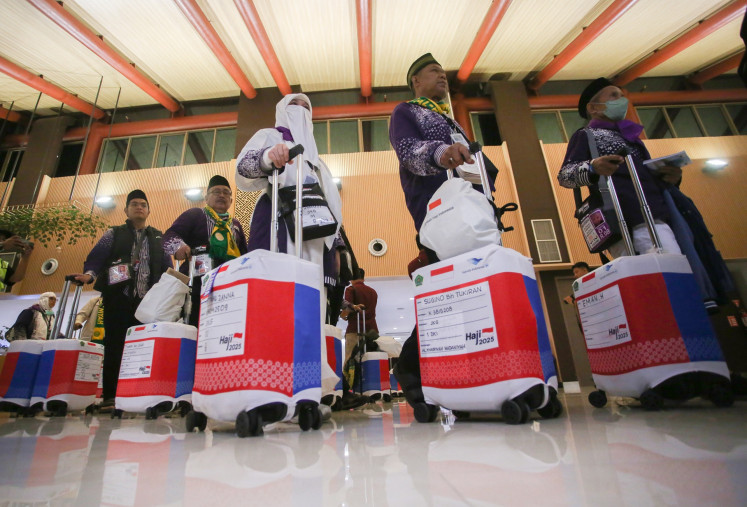Being a midwife to a turtle in Ujung Genteng
Pak Teteng had a midwife’s patience. It was a long night ahead. The mother turtle he was sitting behind had just got comfortable enough to begin laying eggs.
Change text size
Gift Premium Articles
to Anyone
 Sometimes, a turtle will make two or three such pits to camouflage the real one. (Shutterstock/-)
Sometimes, a turtle will make two or three such pits to camouflage the real one. (Shutterstock/-)
P
ak Teteng had a midwife’s patience. It was a long night ahead. The mother turtle he was sitting behind had just got comfortable enough to begin laying eggs.
Plop, plop, plop, one by one, the mother was dropping the eggs into the pit she had dug. She had chosen her spot carefully, high up in the beach, just before the forest began.
Pak Teteng grabbed these slimy ping-pong ball shaped eggs as soon as they came out, putting them in a basket he had brought along, his only tool as the midwife for the night.

Only once everything was settled, could he rest for a few minutes at the makeshift hut he had made at the beach, a plastic sheet resting on three poles, just high enough to sit inside and wide enough to cover his body.
But right now, there was work to do.
Every night, staff from the Turtle Conservation Centre at Ujung Genteng in Sukabumi, West Java, stand watch all night to track nesting green turtles, collected their eggs for safekeeping until they hatch after which they release the babies into the Indian Ocean.
The Turtle Beach at Ujung Genteng, 250 kilometers south of Jakarta, is one of the world’s largest nesting grounds for green turtles.
Earlier we had met Opang and Nyaye, two research students currently stationed at the Turtle Conservation Center. Opang looked like a reggae musician, with long hair and a relaxed air about himself, just how a conservation research scientist should look. Nyaye was like a conventional forest ranger with his lanky physique and wide-brimmed khaki hat.
They had promised to call us at night when there was a turtle. And just as we had gone to sleep, we received the call.
It was drizzling and the kilometer-long walk from our hotel to the Turtle Beach passed through a pitch-dark forest. Yet, the lure of the mother turtle made us rush toward the beach, dodging the countless toads that were practicing long jumps along the cobbled path.
It takes seven hours to reach Ujung Genteng from Jakarta. But owing to heavy long-weekend traffic between Jakarta and Sukabumi, the journey had taken us 10 long hours.
Yet, once we saw this giant mother turtle, who lay completely exhausted after traveling around the world to come back to her ancestral place, we forgot all the hassle of getting there.
That is when we saw Pak Teteng, the patient midwife for the turtles.

“More than 4,000 turtles live here,” said Opang, who was a walking-talking encyclopedia on turtles. “A turtle will only nest at her favorite area. The mothers come once a year. These months, there are one or two every night. But during the peak season from July to August, there could even be 50 turtles in one night.”
The turtles, elegant swimmers in the ocean, are cumbersome on land. Once she was done with laying eggs, she began using her hind flippers to swipe the sand and cover up the pit she had dug for the eggs.
This activity was strenuous for her and she rested after every four or five swipes. She seemed unaware that all her eggs were actually in Pak Teteng’s basket. It was now permitted for visitors to see her from the front. She had beautiful eyes that were tearful.
Opang took away the melodrama, “These are tears to protect her eyes. Turtle’s eyes are better adapted to sea water than air. So these secretions help to put on an additional layer.”
“My research is about finding the relationship between the depth of the nesting hole and the success rate in hatching,” said Opang. “Sometimes, the holes are 50 cm deep. Sometimes, they could dig up to 80 centimeters. Also, one interesting fact about green turtles is that the proportion of male to female varies with the temperature during the hatching period which is usually two months.”
“Sometimes, a turtle will make two or three such pits to camouflage the real one. But tonight, she looks too tired to do all these smart tricks,” said Pak Teteng as he left to bury the eggs in the hatchery.
Turtle sex is rather intriguing too.
“The male climbs on the female and they swim together,” said Opang. “Other males try to get him off by biting his sensitive areas or drag him down. The male has to persevere while he is in so much pain from all the bites from his rivals. It’s a dangerous adventure.”

Once the turtle had covered her pit, she began using her flippers at the front to turn. We tried to help the tired mother by tearing away dry branches that obstructed her movements. After an hour of trying, she finally faced the sea.
Then, she began her descent. It was fast as she went down like a sand-boarder but once she hit the flat beach, it was an arduous task again. She pushed the sand with her flippers and then she rested.
“Judging from her size, she is probably 60 to 70 years old,” said Opang. “She may be anywhere from 60 to 100 kilograms.”
So this turtle would have been born around Indonesia’s independence. However, these great survivors of the wild who can live up to 100 years are now listed as endangered species.
“Look at all those bright lights,” says Opang. Those are all fishing boats. They catch a lot of the baby turtles. They are not supposed to be here as this is a protected area. But this is Indonesia.”
After nearly three hours of nesting, our mother turtle finally swam into the water. I was deeply moved by the effort of this mother who was still behaving as if things hadn’t changed, that she continued believing that her children would inherit a safe and resplendent earth, oblivious to the continuing devastation that we humans have unleashed on her pristine world.
We completed our trip by watching the newly hatched turtles getting released the next evening. Anxious for this great event of nature, we had passed time by visiting the other attractions of Ujung Genteng – the Cikaso waterfall and the infamous surf breaks at Ombak Tujuh.
At sunset, a crowd had gathered at Turtle Beach, tourists from Bandung and Jakarta. Opang was with a megaphone working up the crowd, getting them to cheer the release. Once released, the two-day-old turtles instinctively scrambled for the sea, tripping, flipping, getting swept by the unforgiving waves back to where they had started from. But as the sky, the sand and the sea turned a marvelous red, one by one they disappeared into the open ocean at Ujung Genteng.
“The next few days will be tough for these babies,” says Opang. “They will be eaten up by birds, crabs, and then there are the fishermen’s nets. Only 2 percent of these babies will reach adulthood. We can control things inside this center. But we can’t control the sea.”

I was envious of those 2 percent, those who will outlive me, watching stages in human society that I will not be able to see.
As we said goodbyes to Opang and Nyaye, they mentioned that today was their last day at the center.
“We have spent more than two months here,” said Nyaye. “But it feels like we arrived just yesterday. Here, one doesn’t realize how time passes by.”
The center’s permanent staff came to thank us for our visit.
“They are the real heroes,” said Nyaye. “People like Pak Teteng are the ones doing all the hard work.”
As the crowd departed, the beach became a deserted place with only the waves that battered the fast-walking crabs. The earth darkened itself to prepare for the mothers who would appear later to begin the cycle again. The fishermen on the horizon turned on their neon lights.
***
Writer, traveler, and photographer; India-born Shivaji Das is the author of ‘Journeys with the caterpillar: Traveling through the islands of Flores and Sumba, Indonesia’ and ‘Sacred Love: Erotic art in the temples of Nepal’. He is presently working as a management consultant in Singapore. His full accomplishments can be found at www.shivajidas.com.
---------------
Interested to write for thejakartapost.com? We are looking for information and opinions from experts in a variety of fields or others with appropriate writing skills. The content must be original on the following topics: lifestyle (beauty, fashion, food), entertainment, science & technology, health, parenting, social media, and sports. Send your piece to community@jakpost.com.






